Beach, lunch and a snooze in the sun, Ibiza
When I moan (increasingly) about how desperate I am to go to Ibiza, I think people imagine I’m planning some massive rager in a superclub once I’m off the Covid leash. And OK, yes, fine, after a year and whatever of being trapped inside with my kids, the idea of a wholly responsibility-free night in a room full of happy, sweaty strangers doesn’t repulse me.
But that’s actually not what I’m talking about when I talk about Ibiza. My favourite part of the island is the north, where it’s rocky and wild, but not in the wild-night-out way. I love spending days at little coves such as Cala Mastella and having lunch at El Bigotes restaurant, or one of the simpler places like Cala Xarraca and Cala d’en Serra. At the other end of the island is my favourite restaurant in the world, Es Torrent, where I stuff myself with seafood rice and spend the rest of the day sleeping it off in a sunlounger, like a basking eel. From wintry, locked-down London, it feels like a distant, faded dream.
Hadley Freeman, Guardian columnist
My wild Turkish beach
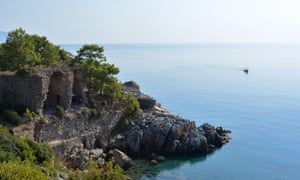
Nine years ago, just days away from finishing an eight-month walk across Europe to Istanbul, I passed a beach on the Turkish Black Sea, somewhere on the wild coast between İğneada and Kıyıköy. I was exhausted, elated and endorphin-fuelled near the end of that journey, and it struck me as one of the most fiercely beautiful places I’d seen: foaming white waves crashing on rocks, thick green forest behind, and a sea so blue it almost hurt my eyes.
There were baby tortoises covering the overgrown path I was on, which added to the magic. I longed to go down there, sleep on the sand, maybe even stay a few days, lose myself one final time. But another, more sensible, voice in my head told me it was time to finish wandering and go home. I didn’t stop there and I’ve regretted it ever since. In this pandemic, that nameless beach – and the wild freedom it represents – feels further away than ever. But I know it’s still there waiting for me, with its baby tortoises.
Nick Hunt, author of Where the Wild Winds Are (Nicholas Brealey, £16.99)
Isolation without menace, Knoydart
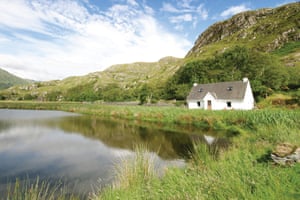
If the weather is right – and in my memory the weather is always right – from the old post house at Kylesmorar you can see across the flat, sheltered waters of Loch Nevis to the black ridge of the Cuillins on the Isle of Skye. This was the view that I was lucky enough to wake up to for a magical week in August last year, a small window of opportunity between lockdowns to visit this spot on the Knoydart peninsula on Scotland’s west coast. Although part of the mainland, it is an island of tranquillity, a 22,000-hectare patch of deer and eagle-haunted wildness cut off from the UK’s road network and reached by boat (or 16-mile hike). Kylesmorar is beautiful, but it is the peace of the place I yearn for.
Whether it is walking mountain paths, swimming in lochs teeming with brown trout, scavenging seafood to eat with carefully rationed wine, or seeing the Milky Way create a foamy wave across the sky, Kylesmorar offers a chance to breathe. In a time where silence and isolation is loud with menace, it would be a balm for the soul to hear nothing but the hiss of waves and the occasional whistle of an eagle.
Matt Gaw, author of Under the Stars, A Journey Into Light (Elliott & Thompson, £9.99)
The beginning of the world in Russia’s far east
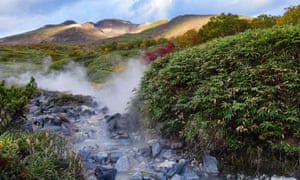
Paolo Cognetti’s book Without Ever Reaching The Summit is a powerful evocation of the traveller’s enduring need to be surprised, and it has made me think of a place I want to return to when this is all over: the Kuril Islands in Russia’s far east, strung like a necklace between Kamchatka and Hokkaido. Soviet historians called them the end of the world but they feel more like the beginning: the haunting mist, the steel-grey ocean scored with pathways of foam, conical volcanoes wrapped in skirts of shimmering jade.
On the Ring of Fire, an extraordinary amount of life bubbles in the gloom: a pod of killer whales, the beady eyes of an otter floating on the sea kelp, the coral-pink feet of migrating seabirds that have travelled half the world. As I remember a journey there in 2017, the Kurils begin to unpeel inside my mind, taking me back to the sunken caldera hidden inside Yankicha Island, halfway down the archipelago. It is dusk, and hundreds of thousands of crested, whiskered auklets swarm into the caldera, skimming the water to find their safe place on an island still being formed. It’s a mesmerising, bewitching affirmation of creation: strange, singular, about as far as you get on Earth from the destructive force of man.
Sophy Roberts, author of The Lost Pianos of Siberia (Transworld, £10.99)
A flaneuse’s reverie around London
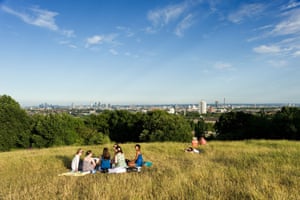
Lockdown made London’s beauty more pronounced to me, as if the emptiness showed its face quite new. One afternoon I drove along the Embankment and up a deserted Regent Street, and it felt majestic, like Paris on a Sunday. It made me want to explore the city again, to spend a long weekend alone with it: to visit the Courtauld, and the National Portrait Gallery, to see the silk-lined walls and all the faces like old friends; to walk down to the river, wander Rotherhithe and Bermondsey, and smell the dark, secret tide-scent on the foreshore.
To wind through the backstreets of the City, Lincoln’s Inn, Smithfield. To St Bartholomew-the-Great to sit in on organ practice. A lunchtime concert at St Luke’s. Something raucous at the Windmill. To find my way through Mayfair, Fitzrovia, Bloomsbury. The long grass on Hampstead Heath. A pint at the Seven Stars in Holborn. A scoop of something from La Grotta Ices in Bermondsey. A trip to Liberty for haberdashery and perfume. Dinner at Hide in Mayfair. Reading on Hackney Downs. A quiet walk along the towpath. Night-scented jasmine on warm east London streets.
Laura Barton, whose book Sad Songs (Quercus, £16.99) is out in May
The Galápagos, to lose and find myself
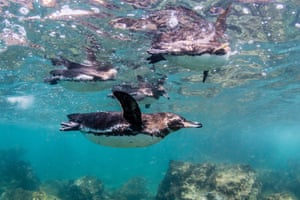
I long for wild places. I’m happiest in landscapes at the edge of things, where animals outnumber humans and where nature is, in a word, epic. In the wild, you can both lose and find yourself. Most years, I seek out such places. This year in particular, I want to feel unfamiliar ground beneath my feet.
I have been fortunate enough to encounter many species of penguin on my travels, but I would especially like to see the Galápagos penguin, the only species that lives north of the equator. The Galápagos, 620 miles west of Ecuador, is the world’s most biologically intact tropical archipelago: “a paradise unlike any other”, as Sir David Attenborough describes it; a “little world within itself”, as Charles Darwin mused. Its geographical isolation has resulted in unique flora and fauna, and wildlife that has never developed a fear of humans. I picture myself face-to-face with a marine iguana, or a giant tortoise. Perhaps even swimming with penguins? I imagine that there I could quite easy lose and find myself again.
Kari Herbert, explorer and author
Alaska to Patagonia: 19,000 miles of open road
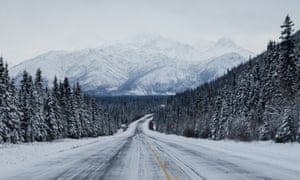
I would love to be alone in Alaska. I’ve never been, but I imagine big skies, cool air, deep forests, the open road. I need, more than I want, to go somewhere that is the opposite of plague-stricken England – so no low clouds or half-hearted drizzle, no news in English or any other language, no delivery vans, no supermarkets, no zombie high streets, no dog walkers. I’ve picked somewhere new because this last year made me realise the value of experiencing different things. The northern end of the 19,000-mile Pan-American Highway is in Alaska. I will buy a big secondhand truck. As I drive south, I’ll stay in cheap motels until the weather improves and people stop carrying guns. Then I’ll camp.
I’ll do hikes along the way to stretch my legs. In Mexico I’ll eat well, because I’ll be fed up with American food. I’ll give hitchhikers lifts if they promise not to mention the pandemic or Donald Trump. Central America will be mainly beaches and sloths. I’ll throw the truck on a ship to get past the Darién Gap, or sell it and use buses through Colombia, Peru and Bolivia. I’ll do something mystical in the high plain before continuing south to Patagonia. I’ll not read any guidebooks. Ideally, I won’t be back home for a long time – or ever.
Chris Moss, travel writer
Germany for a slow boil in the spa
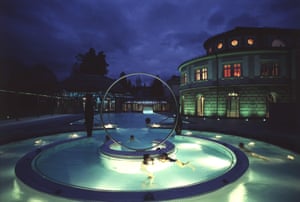
The story of the boiling frog is a fable about the unwillingness of humans to react to threats that arise gradually rather than suddenly. Even so, in these sinister times I’m pining for the heated waters of Badenweiler on the edge of the Black Forest. A spa town where humans have soaked in the warm remedial waters since Roman times, it is now home to a modern spa complex and a few small hotels and restaurants.
After a hearty breakfast of impossibly healthy-looking breads, yoghurts, cheeses and local smoked hams, I will hike in the forest for a few hours, simply to justify the impending indulgence. The next nine hours will be spent limply staggering between numerous herb-scented saunas, indoor and outdoor bathing pools of varying temperatures, and the bar.
Swaddled in bathrobes, large Rothaus Pils in one hand, steering-wheel-sized pretzel in the other, I’ll stare vacantly over the steaming waters towards the dense forest and dark skies behind. No phones, no clothes, just happy humans floating about blissfully unaware of the chaotic outside world.
Tom Kevill-Davies, author of The Hungry Cyclist: Pedalling the Americas in Search of the Perfect Meal, and owner of the Hungry Cyclist Lodge in Burgundy
New York’s Lower East Side
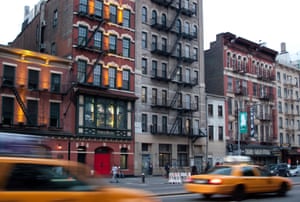
Winter jostling against spring. Splash of East River in full swing below Williamsburg Bridge. I am walking tonight towards the Bowery. Traffic lights become apples bursting their greens, sending them dappled through car windscreens, each light looking directly at me, saying: “Now is the moment that was made for you!” And I know beyond doubt I must move – that whatever has been holding me back has been removed – as I slip through the hum of the traffic, through sirens and screeches and static. A hundred different songs play through a hundred different doors – I lean up against them all.
Every surface, every crevice of the street, I smudge myself into. I rub my back against walls like a bear. I stick to the sweat in the air. A blue door opens to a sound that is loud but soft, muffled where conversations cross – Bowery Poetry. A beer clinks open in front of me. The glass is cold and wet to the skin. The stage is lit and the show begins.
Elizabeth-Jane Burnett, poet
Sa Foradada restaurant, Mallorca
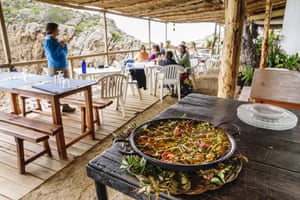
It is round about 2pm on a ramshackle wooden deck jutting over the sea. We are dusty and happy after the hour’s steep hike down a footpath from the coast road to the tiny blue bay of Sa Foradada on the west coast of Mallorca, which is how you get to this beach restaurant if you don’t have a yacht. The first icy cans of Estrella have been snapped open, bread and alioli and pebble-sized green olives are on the table. Some of the kids have disappeared for a pre-lunch swim, but I’ll wait until later. There’s no rush; we’ll be here for hours.
The musky prawn-head scent of paella drifts from the kitchen. We eat and chat and drink and watch the teenagers bomb off rocks into the waves and the posher clientele arrive on their boats. A Balearic beach lunch is my happy place. It could be Ca’s Patro March, of Night Manager fame, just down the road in Deia; Cala Bonita in Ibiza is bliss. But Sa Foradada is my ultimate. (You don’t have to take my word for it – Yotam Ottolenghi eats here, too.) Before all this, my travel plans were about new adventures. But now my dreams are full of the friendly ghosts of summers past.
Jess Cartner-Morley, Guardian associate fashion editor
Aquatic therapy in Folegandros

This island in the Cyclades is only 12km long and shaped like a camel’s hump. One thing I’m looking forward to is spending a summer night under the bougainvillaea of Chora, its clifftop capital, drinking a negroni and thinking about what I’d like for dinner. But the place on the island I’m most eager to return to is one of its beaches, Livadaki.
There’s no road to it, so getting there means at least an hour’s walk along rocky paths through a scrubby, Homeric landscape of drystone walls and wild thyme. I’d make sure to stock up on fruit juice and snacks from a shop in sleepy Ano Meria (at the top of the hump) before setting off. It’s the effort of the walk that makes arriving at Livadaki feel so special. You cut down from the clifftop to a pebbly cove filled with astonishingly clear blue water. There’s something profoundly healing about swimming lazily out into the Aegean, over the dark sea sponges, parrotfish, rainbow wrasse and shoals of tiny sardines.
Marcel Theroux, broadcaster and author of The Secret Books (Faber & Faber, £12.99)
Peru – and a refreshed Machu Picchu
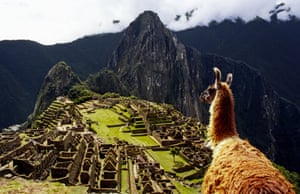
I have been going to Peru for more than 40 years, and I’m looking forward to returning with renewed energy when this is all over – particularly as my Peruvian friends tell me the cloud forest area around Machu Picchu, having had time to refresh without any of the usual tourists, is looking stunning.
There’s a great hotel at the bottom of the Machu Picchu hill, the Pueblo, where you can guarantee that every day a cluster of rare hummingbirds will be feeding outside your door. The Unesco-listed ruins of Machu Picchu are extraordinary, but people forget that it has the unusual distinction of also being a Unesco biosphere reserve, and the surrounding cloud forest is teeming with rare orchids.
On the way back to Cusco, I will stop off at one of my favourite little roadside restaurants, Los Geranios in Urubamba. It has a sunny little hidden courtyard, with some melancholy huayno music playing and a menu that never seems to change. I will be ordering chicharrones, the deep-fried pork belly delicacy of the Andes, and maybe some tamales. And then ice-cream made from jungle fruits to follow. Heaven.
Hugh Thomson, author of The White Rock: An Exploration of the Inca Heartland (Orion, £12.99)
Summer solstice in Estonia
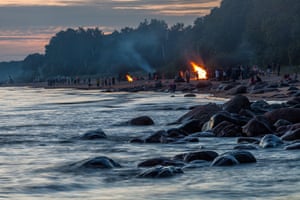
On Midsummer Eve I’ll be in an Estonian forest, if the demons can be kept at bay. On my last, pre-lockdown, journey across eastern Europe, I dawdled by Lake Võrtsjärv, where the rings of forest smell of resin and blueberry leaves. Tapering trunks glow luminous red in the evening light. Fresh breezes whisper through the treetops, tracing audible paths through the pines while, underfoot, billowy green hummocks of sphagnum moss cushion the forest floor. Estonia’s summer solstice – Jaanipäev, when dawn meets dusk – is the country’s wildest, oldest annual celebration. Families head to the woods, gather with neighbours, sing around bonfires on pebble beaches and sweat like swine in backroom saunas.
Then as the sun dips below the horizon and rises right up again, mothers and daughters, youngsters and oldsters jump over the fires to invite in prosperity and drive away malicious spirits. Those spirits have been too active over the past year, so this 24 June the fires will roar – for the brighter and higher the flames, the further away the fiends will retreat. And with their banishment, the bravest among us will streak down the banks and into the shockingly cold fresh water, to float on our backs and gaze at the stars, hoping for a gentler, kinder year.
Rory MacLean, author of Pravda Ha Ha: Truth, Lies and the End of Europe (Bloomsbury, £9.99)
High peaks, coral reefs and big blue spiders
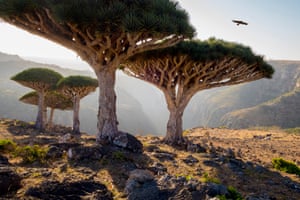
I’d love to be in Socotra – an island in the Arabian Sea off the coast of Somalia. It’s a year since I set foot on this fantasy film set of an island, where dragon’s blood trees dot the landscape, the people are warm and welcoming and the politics are a mess – as you would expect in an isolated chunk of land that is officially part of Yemen.
There’s so much I didn’t see on that all-too-brief visit last February and, having written a guide to the island with the help of experts and other travellers, I know how much I missed. I want to see the sea’s bioluminescence at night from the top of a sand dune, to snorkel over one of the least-disturbed coral reefs in the Arabian Sea and to trek into the Haggeher mountains – which are ridiculously high (over 1,500 metres) for an island barely the size of Cornwall. And I need to find more of the endemic species – especially the jaunty chameleon and the amazing blue baboon tarantula. Who knows when travel to Socotra will again be possible, but I can nurture the dream.
Hilary Bradt, guidebook publisher
The snows of far-off places
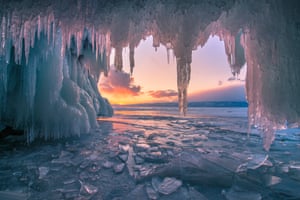
Deprived of my usual winter trip to the Alps, I’ve developed an obsession with more distant snows. Walking the dog, I’m listening to Apsley Cherry-Gerrard’s The Worst Journey in the World. I’m poring over author Caroline Eden’s recipes for Uighur noodles and Georgian dumplings. Now, having made short work of Dervla Murphy’s Through Siberia by Accident, I find myself in Baltistan in midwinter, trudging with her through snow drifts in the shadow of the Himalayas. Periodically, I break off to explore these places online, noting with a pleasurable shiver that it is -11C in Baltistan’s capital, Khaplu, where Dervla and her six-year-old daughter take tea with the deposed Raja, or that Siberia’s Lake Baikal is frozen solid, but still popular with Instagrammers. Last weekend, I even found myself investigating volunteering opportunities with the British Antarctic Survey. Help!
Felicity Cloake, Guardian food writer
Albania on the trail of King Zog

I was supposed to go to Albania for the first time in 2020. I had been commissioned to write a crime novel set there in the 1930s, but then – Covid. So as soon as I can, I am going. All the destinations I want to visit – the stylish resort of Durrës on the Adriatic, the wild Bjeshkët e Namuna (Accursed Mountains) in the north and the province of Mat in the east – are connected to King Zog, who ruled the country in the 1930s and stars in my novel. He also knew my dad, so this is a personal pilgrimage, too.
The Accursed Mountains are a tough, spiky range, home to wolves, Balkan lynx and hundreds of kullë, towers built to protect people during blood feuds. Mat is also known as the Land of Kings. Albanian national hero Skanderbeg was born in Mat, as was Zog. The son of a tribal chief, Zog was educated in my beloved Istanbul and survived an assassination attempt while giving a speech. Bleeding from two gunshot wounds, he carried on talking for another half-hour. I can’t wait to go.
Barbara Nadel, crime writer
A multitude of majestic seabirds in St Kilda
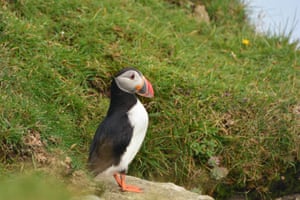
Something weird happened in this house during lockdown one. Our boys, eight and six, hitherto interested only in Match Attax, got into birds. We hung feeders in the garden, enjoyed tits and goldfinches. Then – big excitement – a sparrowhawk, also enjoying tits and goldfinches. We got a book, binoculars, went to the park, saw woodpeckers both green and greater spotted. One night we heard an owl. Maybe.
We’re bored with the park now. We want to see more birds, and views like the massive cliffs in the book, alive with seabirds. Can we go to St Kilda? they asked. I’ve been to this archipelago west of the Outer Hebrides and know it’s not easy to get to. Also that it’s special and as far away – in spirit as well as distance – as it’s possible to get domestically from the bloody park.
So, yeah, I think we can. One day we’ll cross the sea – God we’ve missed the sea, and space, and sky – look up and marvel at the towering stacks, alive with a million gannets, petrels, shearwaters, kittiwakes, puffins. Puffins!
We haven’t told their mum yet; she wants to go to France, to drink rosé on a terrace. We can do that too.
Sam Wollaston, Guardian journalist
Tenerife – the wine world’s best-kept secret
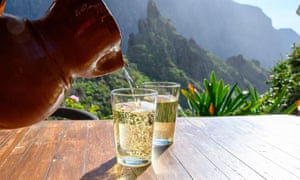
When I begin to write a new novel, I always sneak away to the sun of Tenerife, to allow the characters I’m dreaming up start to come to life – and I’d like to be there right now. In between scribbling notes and walking by the sea and writing, I’ll head for the wild hills and mountains to the north of this volcanic island where the original inhabitants, the Guanches, lived possibly as far back as 6000 BC.
In the 16th and 17th centuries, Tenerife was one of the world’s major wine producers – there are five appellations today – so I’ll visit either Bodega la Haya, in the Valle de la Orotava, where the vines are grown horizontally in the oldest known method, or to Viña Zanata in Ycoden-Daute-Isora. There, in an internal courtyard fringed with palm trees, we’ll taste crisp white wines and strong rosés, served with bread and olive oil, fresh tomatoes, slices of ham or manchego cheese, cubes of tortilla and the island’s speciality, patatas bravas with mojo verde. The perfect way to spend an afternoon.
Kate Mosse, author of The City of Tears (Mantle, £20)
Dream beach, Zanzibar

Ten years ago, I found myself on what, to me, is the world’s most perfect beach: a sliver of Zanzibar, miles from the gated resorts of nearby Pemba island. At dawn, the tide was low and seaweed-pickers splashed ankle-deep through the water, their silhouettes framed against pink sky. But as the air warmed up, the water rose, and the sun rolled overhead, they slipped away, leaving the beach deserted. I sat on sand as white as sifted flour. Hearing nothing but the snap and rustle of colobus monkeys leaping through the trees, I could smell the smoke from prawns being grilled at my lodge, and waded into waist-deep water for a pre-lunch dip. Nature’s infinity pool, this strip of the Indian Ocean sparkled, miles of green and blue hues bleeding into one, as I half swam, half crawled through water so clear I could see the stripes on the fish darting around my knees.
Reaching a finger of sand where crabs zigzagged in and out of holes, I sat cross-legged in the sea and looked back at the beach whose name I will for ever keep a secret.
Monisha Rajesh, author and journalist
A (very) long walk across England
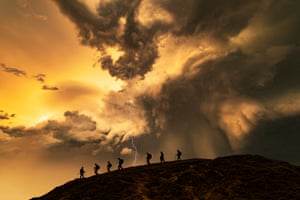
Movement. That’s what I’m craving most. More than wanting to whisk myself to a specific summit, seaside or Parisian cafe, I am dreaming of the whisking itself: the mechanics of being on a long-distance, multi-day walk to almost any destination.
So long as the getting there takes time, and means not being restrained inside a bubble or forced to return to my own four walls each night. Before this hiatus, I had planned to take a sabbatical: to hike out of my front door and keep roaming across the country until I returned, maybe two, three, four months later. That’s what I want to do now. I live in Bath, so would probably start by following the Cotswold Way north, straight out of the city into the chocolate-box hills.
Then I’d keep going – maybe stringing together the Heart of England Way and Derwent Valley Heritage Way to get up to the Pennines, before striking west into the Lakes. There would be multiple decisions to be made with each mile. Every day different, as opposed to every day being the same …
• More information at National Trails, and the Long Distance Walkers Association
Sarah Baxter, journalist





